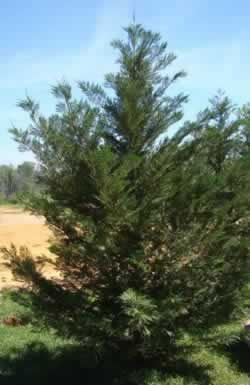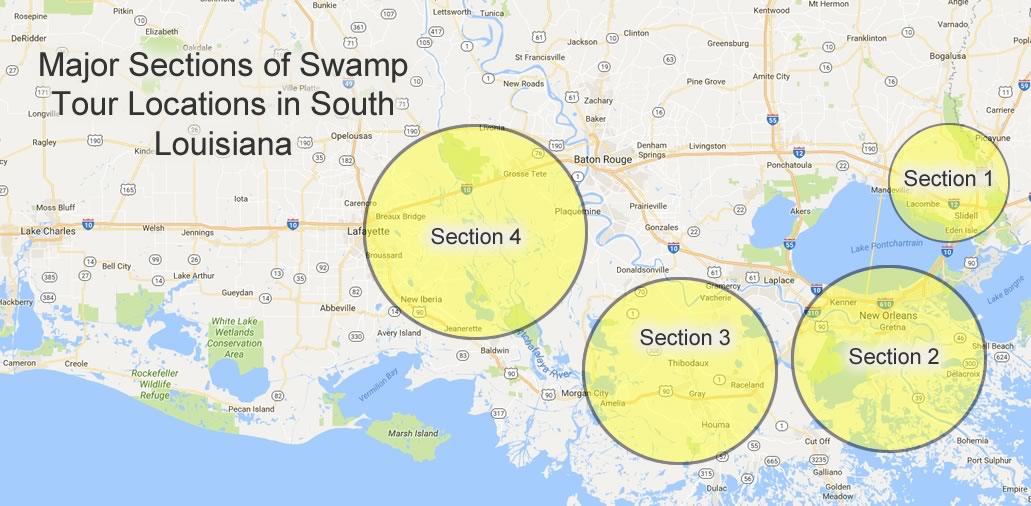
The Ageless Beauty of the Louisiana Cypress Swamp
 Cypress swamp in Louisiana |
A swamp is an area of land permanently saturated, or filled, with water.
The lush growth in a Louisiana swamp is indescribable. You have to see it to believe it.
The most impressive objects in the swamp are the cypress trees which are very graceful in their structure, with their reddish bark, exquisitely bent branches, and delicately fine leaves.
Bald cypress prefer wet, swampy soils on riverbanks, floodplains, or wet depressions, but are widely adaptable. Unlike most conifers (which are evergreens), the bald cypress is deciduous, and loses its needles in the fall, giving the tree a "bald" appearance).
The Louisiana Cypress grows slowly, but can grow to great height, so that in some swamps, though tall, they will not have a cone on top, which has been swept away by past hurricanes. Cypress trees can live to be hundreds of years old.
 |
The Great Atchafalaya Basin and Swamp
 Louisiana's Atchafalaya Swamp at Henderson (photograph by the author) |
The Atchafalaya Basin is the nation’s largest river swamp, containing almost one million acres of the nation’s most significant bottomland hardwoods, swamps, bayous and backwater lakes.
The Atchafalaya River meanders from near Simmesport southward past Pierre Part down to Morgan City and the Gulf of Mexico. The Atchafalaya Basin is a unique combination of wetlands, bayous, marshes, estuaries,and river delta area. It is often called "America's Wetland", and covers an area 20 miles wide and 150 miles long.
Some interesting facts about the Atchafalaya Basin:
- It’s larger than the Florida Everglades.
- It’s five times more productive than any other river basin in North America.
- About 65 species of reptiles and amphibians inhabit the Basin.
- Over 250 known species of birds fly in the Basin.
-
Other species of animals found in the area include the Florida panther, black bear, bobcat, nutria, mink, fox, muskrat, beaver, otter and raccoon.
Atchafalaya Swamp Visitors Center in Butte LaRose, near Henderson on Interstate Highway I-10 (Staff Photo) - The Basin is home to the largest nesting concentration of bald eagles in the south central United States.
- There are more than 100 different species of fish and aquatic life in the Basin.
- The Basin has an estimated average annual commercial harvest of nearly 22 million pounds of crawfish.
- The Basin contains the largest contiguous bottomland hardwood forest in North America and is the largest overflow alluvial hardwood swamp in the United States.
An American-Indian word, "Atchafalaya" (ah-CHA-fa-LIE-ah) means long river. Established in 2006, the Atchafalaya National Heritage Area stretches across 14 parishes in south-central Louisiana.
It is among the most culturally rich and ecologically varied regions in the United States, home to the widely recognized Cajun culture as well as a diverse population of European, African, Caribbean and Native-American descent.
Read more about the Atchafalaya Basin Swamp.
Honey Island Swamp in Southeast Louisiana
One of the most natural and least-altered river swamps in the United States is the Honey Island Swamp.
It is located in southeast Louisiana in St. Tammany Parish.
The swamp is bordered on the north by U.S. 11, on the south by Lake Borgne, on the east by the Pearl River and the west by the West Pearl River.
Read more about the Honey Island Swamp.
Louisiana Swamp Tours
One of the most popular things to do for visitors to Louisiana is touring the swamps! Most tours are concentrated in South Louisiana as shown in the map below of major concentrations of swamp tours.
In the greater New Orleans area, there are many swamp tour options in communities such as Marrero, Westwego, Braithwaite, Lafitte, Des Allemands and Laplace.
Others tours originate in South Louisiana cities such as Breaux Bridge, Henderson, Slidell and Thibodaux as well as in the Atchafalaya Basin.
Other Louisiana Swamps, Wetlands and Wildlife Refuges
Louisiana has some of the most extensive wetlands, swamps, marshes, bottomlands, estuaries and river systems in the United States. A partial list is included below:
- Bayou Teche National Wildlife Regus - 9,000 acres of bottomland forest and swamp
- Upper Ouachita National Wildlife Refuge - 43,000 acres in Union and Ouachita parishes
- Bayou Sauvage National Wildlife Refuse - 24,000 acres urban refuge
- Bogue Chitto National Wildlife Refuge - 36,000 acres of riverine swamps and hardwood uplands
- White Lakes Wetlands Wildlife Conservation Area - 71,000 acres south of Gueydan in the Mermantau River Basin
- Rockefeller State Wildlife Refuge - 76,000 acres of coastal marsh located in Cameron and Vermilion parishes on the Gulf of Mexico
- Sabine National Wildlife Refuge - 125,000 of coastal marsh located between Sabine and Calcasieu lakes
Earliest Uses of Cypress in Louisiana
The wood produced from the Louisiana Cypress will not rot, is resistant to insects, and yet being a hardwood, is a soft one and easy to work.
From the earliest days of European settlement, Louisiana cypress trees served the people moving into the area. Cypress wood was beautiful. It was resistant to decay, a good thing in the humid Louisiana environment. It was used for caskets, water tanks, fortresses, ships and in the construction of homes and animal shelters.
The first settlers in the region used cypress lumber for their houses, fences and boats but it was not until the late 1800s that extensive cypress harvesting began. Production peaked around 1913; and by the 1930s all but scattered small islands of cypress had been cut-over.
And for a State susceptible to hurricanes and tropical storms, the vast coastal cypress forests help to protect the Louisiana coast from the ravages of violent storms and erosion of the coastline.
Cypress Knees
When located in swampy soils, the bald cypress forms "cypress knees" with age that grow up from the roots, probably for stability.
Lowland or swamp-grown cypresses found in flooded or flood-prone areas tend to be buttressed and "kneed."
Some scientists also believe that the knees may help in providing oxygen to the tree. In areas where the cypress roots are submerged, the knees, a part of the root system, stand above the water level and they may help bring oxygen to the tree.
Cypress: The Official Louisiana State Tree
Selected for its historical and economic importance to the state as well as its abundance and its aesthetic beauty, a bill was drafted and passed through the Louisiana Legislature.
By legislative Act No. 49, the bald cypress was made the official state tree of the state of Louisiana on May 26, 1963.
Act No. 49 identifies the official tree as "bald cypress" (Taxodium distichum), offering that the bald cypress is commonly known as the "cypress" tree. Today, the tree is often referred to as the bald cypress.
Sinker Cypress
Sinker cypress can be found in bogs, bayous, and river bottoms from North Carolina to Texas, wherever 19th century loggers cut old growth timber and used waterways to float the logs downriver to mills close to ports where the lumber could be shipped and used to build growing settlements and cities.
Well before the Civil War, loggers upriver would cut their lumber and tie it together - sinkers and floaters - to take downriver. Often they would lose some logs along the way, which have become today's sinker cypress, sinker pine, even walnut and other varieties. Over the years, the river bottom became inundated with these logs, which are prized today for their color and very tight ring count.
Legacy Cypress Trees in Louisiana
The largest bald cypress in the United States is located in Louisiana on Cat Island near St. Francisville. The massive tree measures 53 feet in circumference at breast height. The very durability and sturdiness that made cypress the wood of choice for the building of New Orleans and towns all over Louisiana has helped the surviving old giants endure through the centuries.
The intent of the Louisiana Purchase Cypress Legacy program is to commemorate the state's natural heritage by identifying and landmarking trees, with an emphasis on the bald cypress and tupelo, that are at least 200 years old, and alive at the time of the Louisiana Purchase.
Patterson: Cypress Capitol of Louisiana
The Louisiana State Museum system operates a facility in Patterson, Louisiana, housing two unique museums. The Wedell-Williams Memorial Aviation Museum is named after Jimmie Wedell and Harry Williams, two of Louisiana's aviation pioneers, the museum showcases numerous aircraft, 1930s air race trophies and memorabilia.
 |
Included in the same building is the Cypress Sawmill Museum which exhibits a variety of artifacts, photographs and films of this early regional industry. Cypress lumber harvested and milled in Louisiana was shipped in mass quantities across the United States.
The town of Patterson was once home to the largest cypress sawmill in the world, owned by Frank B. Williams, and in 1997 the Louisiana State Legislature designated Patterson as the Cypress Capitol of Louisiana.
The Patterson Cypress Sawmill Festival is an annual event held the first weekend of April at Kemper Williams Park in Patterson. Attendance is normally about 35,000 for a three-day event. The festival is a family oriented and community event. It consists of a midway with amusement rides and games, arts and crafts show, car show, poker run, fun walk, gumbo cook-off, softball tournament, fishing tournament, golf tournament, petting zoo, old engine display, RV camping, lumber jack show, musical entertainment, and lots more!
Harvesting of Cypress Trees in Louisiana Today
 Louisiana Leyland Cypress (Staff Photo) |
Of the approximately one million acres of cypress found in Louisiana in the 1800s, an estimated 800,000 acres exists today, totaling about 1 billion board feet. These trees have been growing for 100 plus years. Some estimates that Louisiana has 221 million board feet of growth each year. The annual cypress harvest is estimated at 30 million board feet of cypress each year.
During the early 2000s, many cypress swamps were clear cut to make cypress mulch. This process became a volatile issue, and today much of clear cutting has been halted.
Cypress is used today to make porch swings, tables, furniture, ceiling beams, cabinets, and other products requiring a durable wood. The Leyland Cypress is commercially grown in Louisiana for use as "you cut it" Christmas trees, and as a popular residential landscape tree.
The Forestry Industry in Louisiana
Louisiana’s forestlands cover 48% of the state’s area, totaling 13.8 million acres. Private, non-industrial landowners own 62 percent of the state's forestland, forest products industries own 29 percent and the general public owns 9 percent.
This renewable resource provides the raw material for Louisiana’s second largest manufacturing employer: the forest products industry, which includes over 900 companies in 45 parishes directly employing over 25,000 people.
An additional 8,000 people are employed in the harvesting and transportation of the resource. Louisiana’s forests provide a multitude of other benefits, including clean air and water, wildlife habitat, recreational opportunities and scenic beauty. For more information, visit the website of the Louisiana Office of Forestry.
| More Louisiana Travel Information | ||
 |
 |
 |
 |
 |
 |
 |
 |
 |
Links of Interest about Louisiana
- Louisiana Office of Forestry
- Louisiana Purchase Cypress Legacy
- Cypress Sawmill Festival
- Louisiana Office of Tourism
- Louisiana Office of State Parks
- Louisiana Travel: Official Site
- Louisiana Alligators
